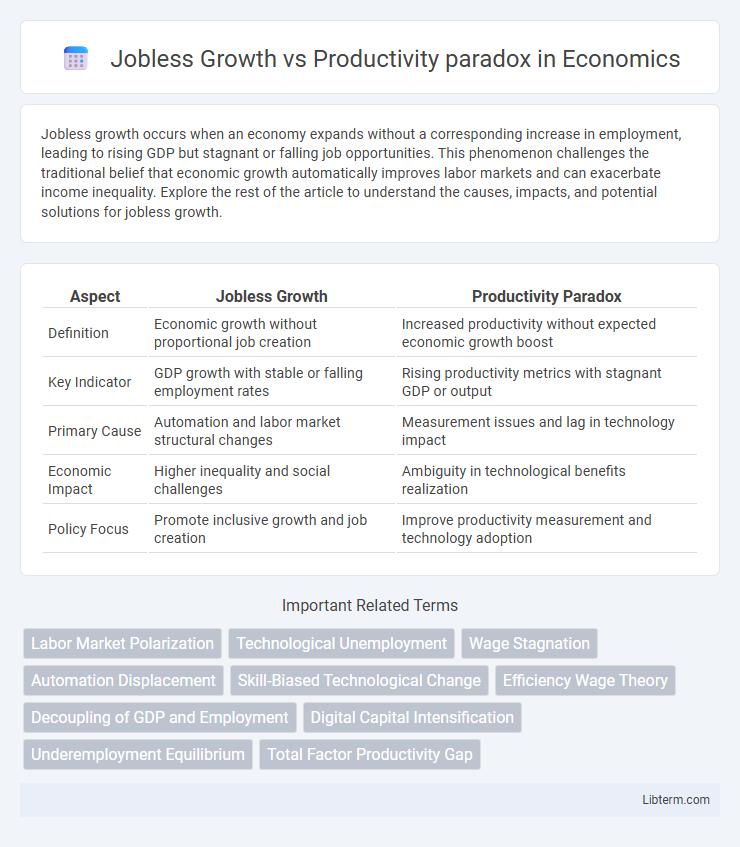Jobless growth occurs when an economy expands without a corresponding increase in employment, leading to rising GDP but stagnant or falling job opportunities. This phenomenon challenges the traditional belief that economic growth automatically improves labor markets and can exacerbate income inequality. Explore the rest of the article to understand the causes, impacts, and potential solutions for jobless growth.
Table of Comparison
| Aspect | Jobless Growth | Productivity Paradox |
|---|---|---|
| Definition | Economic growth without proportional job creation | Increased productivity without expected economic growth boost |
| Key Indicator | GDP growth with stable or falling employment rates | Rising productivity metrics with stagnant GDP or output |
| Primary Cause | Automation and labor market structural changes | Measurement issues and lag in technology impact |
| Economic Impact | Higher inequality and social challenges | Ambiguity in technological benefits realization |
| Policy Focus | Promote inclusive growth and job creation | Improve productivity measurement and technology adoption |
Understanding Jobless Growth: Definition and Causes
Jobless growth refers to economic expansion characterized by increased Gross Domestic Product (GDP) without a corresponding rise in employment levels, posing challenges to inclusive development. The primary causes include rapid technological advancements that enhance productivity through automation and artificial intelligence, reducing the demand for labor in traditional sectors. Structural changes in the economy, such as shifts from manufacturing to service industries, and labor market rigidities also contribute significantly to this paradoxical phenomenon.
The Concept of the Productivity Paradox
The productivity paradox highlights the contradiction where significant investments in technology and innovation do not translate into expected productivity gains or job creation. Despite advances in automation and digital tools, economic growth often occurs without a corresponding rise in employment, reflecting the complexities of labor market adjustments and skill mismatches. This paradox challenges traditional economic theories that link technological progress directly to increased productivity and workforce expansion.
Historical Overview: When Did Jobless Growth Emerge?
The phenomenon of jobless growth emerged prominently during the late 20th century, particularly in advanced economies transitioning through rapid technological advancements and globalization. Historical data from the 1980s onward reveals a decoupling between economic growth and employment rates, where increases in GDP were not matched by equivalent job creation. This paradox intensified with the rise of automation, outsourcing, and shifts toward capital-intensive industries, fundamentally altering labor market dynamics.
Key Drivers Behind Rising Productivity Without Employment Gains
Technological advancements such as automation and artificial intelligence significantly boost productivity by enabling faster and more efficient processes, yet they reduce the need for human labor, causing jobless growth. Capital-intensive industries increasingly rely on machinery and digital tools, which enhance output without a proportional increase in workforce size. Structural changes in the economy, including the shift toward high-tech and service sectors, emphasize skill-biased technological changes that raise productivity while limiting employment opportunities for low- and medium-skill workers.
Technological Advancements and Labor Market Dynamics
Technological advancements, particularly automation and AI integration, have significantly increased productivity but have not translated into proportional job creation, underscoring the jobless growth paradox. Labor market dynamics reveal a shift where routine and manual jobs decline while demand surges for high-skill, technology-oriented roles, exacerbating employment mismatches. This phenomenon highlights structural labor market challenges, including skill gaps and workforce displacement, despite rising GDP and output per worker.
Economic Sectors Most Affected by Jobless Growth
Jobless growth disproportionately affects manufacturing, technology, and financial services sectors, where automation and digitalization reduce labor demand despite output expansion. In manufacturing, advanced robotics and AI streamline production, leading to higher productivity with fewer workers. The technology sector experiences rapid innovation-driven growth but relies heavily on capital and skilled labor, limiting employment opportunities for the broader workforce.
Impact on Wages, Income Inequality, and Social Stability
The Jobless Growth vs Productivity paradox intensifies wage stagnation as productivity increases fail to translate into higher earnings for workers, exacerbating income inequality. Disparities in income widen, concentrating wealth among capital owners and diminishing the middle class's purchasing power, which undermines social stability. Persistent jobless growth erodes social cohesion and heightens risks of unrest by limiting economic opportunities and fueling economic discontent.
Policy Responses: Addressing the Productivity-Employment Disconnect
Policy responses to the Jobless Growth vs Productivity paradox emphasize fostering inclusive growth by incentivizing skill development and innovation to bridge the productivity-employment divide. Governments are promoting labor market reforms, targeted subsidies, and social safety nets to support workforce transitions in technologically advanced sectors. Emphasis on public-private partnerships and investment in digital infrastructure enhances job creation while sustaining productivity gains.
Future Trends: Automation, AI, and Workforce Transformation
The Jobless Growth vs Productivity paradox highlights a growing decoupling between economic output and employment levels as automation and AI technologies increasingly optimize productivity yet reduce labor demand. Future trends emphasize the transformation of the workforce through reskilling and upskilling initiatives to adapt to AI-driven roles while addressing employment displacement in sectors prone to automation. Strategic integration of human-AI collaboration is expected to redefine job structures, fostering new employment opportunities alongside productivity gains.
Rethinking Economic Success: Beyond GDP and Employment Numbers
Rethinking economic success requires moving beyond traditional GDP and employment metrics to address the Jobless Growth vs Productivity paradox, where economies expand without proportional job creation. Emphasizing measures such as workforce engagement, income distribution, and quality of jobs offers a more accurate reflection of societal well-being. Integrating these factors into economic analysis enables policies that foster inclusive growth and sustainable prosperity.
Jobless Growth Infographic

 libterm.com
libterm.com